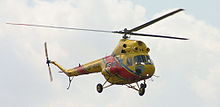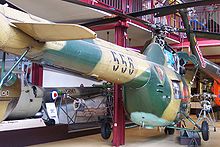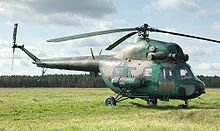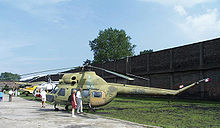- Mil Mi-2
-
"Mi-2" redirects here. For other uses, see Mi2 (disambiguation).
Mi-2 Polish Air Force Mi-2 at Krzesiny Air Base Role Helicopter Manufacturer PZL-Świdnik, Poland[1] [2] First flight September 1961 Introduction 1965 Primary users Soviet Air Force
Polish Military
AeroflotProduced 1965-1985 Number built About 7,200 Unit cost (used)$72,500 Variants PZL Kania The Mil Mi-2 (NATO reporting name is Hoplite) is a small, lightly armored transport helicopter that could also provide close air support when armed with 57 mm rockets and a 23 mm cannon.
Contents
Design and development
The Mi-2 was produced exclusively in Poland, in the WSK "PZL-Świdnik" factory in Świdnik. Production ended in 1985 after about 7,200 were made.
The first production helicopter in the Soviet Union was the Mil Mi-1, modelled along the lines of the S-51 and Bristol Sycamore and flown by Mikhail Mil's bureau in September 1948. During the 1950s it became evident, and confirmed by American and French development, that helicopters could be greatly improved with turbine engines. S. P. Isotov developed the GTD-350 engine and Mil used two of these in the far superior Mi-2. After initial development at the Mil bureau (Soviet designation V-2) this was transferred to Poland in 1964, after the first Świdnik-built example had flown. PZL-Świdnik has since delivered many hundreds, possibly one-third of them to military customers, and developed plastic rotor blades and the wide-body Mi-2M seating 10 passengers instead of eight. Most typical role kits include four stretchers, as air ambulance, or aerospraying or cropdusting device.
In Poland, there were also developed several specialized military variants, first of all support or reconnaissance ones, with 23 mm autocannon, machine guns and/or two 57 mm rocket pods, four 9K11 Malyutka anti-tank missiles or Strela-2 AA missiles.
Operational history
It was first introduced into the Soviet Air Force in 1965. The Mi-2 is used by mainly former Soviet and Eastern Bloc countries, although it is used by Mexico and Myanmar as well.
Most of armed Mi-2 variants were used by Poland. Some were also used by the former East Germany (with machine gun and unguided rocket armament only).
North Korea still maintains a large active fleet of Mi-2s. In the event of a war with the ROK, the primary mission of the 200+ aircraft would be the insertion of nK SOF forces behind enemy lines. These SOF forces would be tasked with opening the "second front" against the allied forces, in order to disrupt their ability to counter the nK invasion. The life-expectancy for the Mi-2s would be short, and many would likely not return from their initial mission.[citation needed]
Variants
 Mi-2Ch exhibited in Polish Aviation Museum
Mi-2Ch exhibited in Polish Aviation Museum
 Mi-2 Plus old air ambulance LPR in Poland
Mi-2 Plus old air ambulance LPR in Poland Mi-2P exhibited in Polish Army Museum in Warsaw. Helicopter in markings of the 42 eskadra lotnicza MSWiA based at Warszawa-Bemowo airfield.
Mi-2P exhibited in Polish Army Museum in Warsaw. Helicopter in markings of the 42 eskadra lotnicza MSWiA based at Warszawa-Bemowo airfield.
- V-2
- First prototype.
- V-2V
- Armament prototype.
- Mi-2 Platan
- Aerial minelayer version.
- Mi-2A
- Mi-2B
- Upgraded export version for the Middle East, fitted with improved systems and navigational aids.
- Mi-2Ch Chekla
- Chemical reconnaissance / smokescreen layer version.
- Mi-2D Przetacznik
- Aerial command post equipped with R-111 radio.
- Mi-2FM
- Survey version.
- Mi-2P
- Passenger / cargo version, with accommodation for 6 passengers.
- Mi-2R
- Agricultural version.
- Mi-2RL
- Land rescue/ambulance version.
- Mi-2RM
- Sea rescue version equipped with electric winch for two people and dropped rafts.
- Mi-2Ro
- Reconnaissance version equipped with cameras.
- UMi-2Ro
- Reconnaissance trainer version.
- Mi-2RS Padalec
- Chemical and biohazard reconnaissance version.
- Mi-2S
- Air ambulance version, equipped to carry four litters, plus an attendant.
- Mi-2Sz
- Dual-control training version.
- Mi-2T
- Cargo/utility version.
- Mi-2U
- Dual-control training version.
- Mi-2US
- Armed version fitted with a fixed 23mm NS-23 cannon, 4 x 7,62mm PKT machine gun pods and optional cabin PK machine gun.
- Mi-2URN Żmija ('Viper')
- Armed reconnaissance variant armed with a fixed 23mm NS-23 gun and two 16x57mm S-5 unguided rocket pods Mars-2. Optional 7,62mm PK machine gun window-mounted.
- Mi-2URP Salamandra ('Salamander')
- Gunship and anti-tank variant, armed with 23mm NS-23 gun, optional window-mounted 7,62mm PK machine gun, and 4x AT-3 Sagger (9M14M Malutka) wire-guided missiles on external weapons racks and 4x additional missiles in the cargo compartment.
- Mi-2URP-G Gniewosz
- Mi-2URP with additional 4x AA missiles Strzała-2 (Strela 2) in two Gad rocket launchers.
- Mi-2 Plus
- Upgraded Mi-2 with uprated GTD-350W2 engines, all-composite rotor blades, new avionics and some other modifications.
- Mi-3
- Planned Mi-2 derivative that lacked suitable engines for the program to continue.
- Mi-2MSB2
- Modernized by the Ukrainian Air Force, will enter the serial modernization/production in late 2011.
Operators
 Ex-East German Air Force Mi-2 in Hubschrauber Museum, Bückeburg
Ex-East German Air Force Mi-2 in Hubschrauber Museum, Bückeburg
 Peruvian Army Mi-2 on display at Las Palmas Airbase, 2006
Peruvian Army Mi-2 on display at Las Palmas Airbase, 2006
- Afghan Air Force - Unconfirmed reports of six in service around 1982 and 1983.[3]
- Albanian Air Force operated two Mi-2s from 1981 through 1986.[3]
- Azerbaijani Air Force
- Bulgarian Air Force - Former operator
- Cuban Air Force
- Czechoslovak Air Force passed on to successor states.
- 2 in Estonian Aviation Museum
East Germany operated 48 helicopters, in 1972-1990, also an armed variant[4]
- Luftstreitkräfte der NVA
- Nationale Volksarmee
- Grenztruppen der DDR
- Bundesluftwaffe operated former East German helicopters.
- Budapest Aircraft Service
- Hungarian Air Force
- Hungarian Police
- Indonesian Air Force acquired their Mi-2s in 1961 and used during the Operation Trikora in 1962 in Western New Guinea. The Mi-2s were largely grounded in 1969 and were subsequently removed from service in 1970 (one of these helicopters was given to the Museum "Satria Mandala", Jakarta)
- Indonesian Navy (TNI-AL) bought 16 Mi-2s in 2003. But only 3 helicopters remain operational (though none are airworthy) and 13 others haven't arrived due to problems with Indonesian Navy's logistics.[5]
- Indonesian Police (Polisi Lintas Udara) also operates Mi-2 helicopters. All of the helicopters are old variants of Mi-2.[6]
- Indian Navy Have 2
- Free Libyan Air Force
- Mongolian People's Air Force - Operated 2 Mi-2 helicopters, but sold to China in 1991.
 Mexico
Mexico Myanmar
Myanmar
- Myanmar Air Force received 20 armed Mi-2 helicopters.
- North Korean Air Force - locally produced
- Polish Air Force
- Polish Army
- Polish Border Guard
- Polish Navy
- Polish Police
- Peruvian Army six aircraft, not operational.
 Soviet Union
Soviet Union- Passed on to successor states.
- Redstar Aviation operated three helicopters since 1992.
- Cold War Air Museum (CWAM) operates 4 Mi-2s from its Museum at Lancaster Airport (Texas) just south of Dallas, Texas.[7]
- U.S. Army is said to have a few Mi2 Hoplites for training purposes located at Fort Bliss, Texas. The Hoplite is used to train pilots in Soviet aircraft before moving to larger Soviet helicopters such as the Mi24.
- U.S. FAA registry lists 13 privately owned Mi-2s operated by civilians. Only 4 of the 13 have Airworthiness Certificates.[8]
Specifications (Mi-2T)
Data from[citation needed]
General characteristics
- Crew: One
- Capacity: 8 passengers or 700 kg (1,540 lb) internal, 800 kg (1,760 lb) external cargo
- Length: 11.9 m (39 ft 4 in)
- Rotor diameter: 14.6 m (47 ft 11 in)
- Height: 3.7 m (12 ft 2 in)
- Disc area: 167 m² (1,797 ft²)
- Empty weight: 2,372 kg (5,218 lb)
- Loaded weight: 3,550 kg (7,810 lb)
- Max takeoff weight: 3,700 kg (8,140 lb)
- Powerplant: 2 × PZL GTD-350 turboshafts, 298 kW (400 shp) each
Performance
- Maximum speed: 220 km/h (138 mph)
- Range: 340 km (212 mi)
- Service ceiling: 4,000 m (13,120 ft)
- Rate of climb: 4.5 m/s (886 ft/min)
- Disc loading: 21 kg/m² (4.3 lb/ft²)
- Power/mass: 170 W/kg (0.10 hp/lb)
See also
- Related development
- Aircraft of comparable role, configuration and era
References
- ^ Łukasz Męczykowski, Mi-2. Polski hoplita, "Histmag.org", 25 czerwca 2009.
- ^ Благовестов А. – Каталог современного оружия ведущих стран-производителей
- ^ a b "Historical Listings", World Air Forces
- ^ Thomas Girke, Georg Bader, NRD-owskie Mi-2 in: Lotnictwo Wojskowe 2/1999, page 46-48 (Polish)
- ^ TEMPO Edisi 19-25 Maret 2007 (page 36-37)
- ^ ANGKASA No.07 Edisi April 2007 (page 16)
- ^ U.S. FAA - Registry of Aircraft - Mi2 - Texas
- ^ U.S. FAA - Registry of Aircraft - Mi2
External links
Mil aircraft Lists relating to aviation General Aircraft (manufacturers) · Aircraft engines (manufacturers) · Airlines (defunct) · Airports · Civil authorities · Museums · Registration prefixes · Rotorcraft (manufacturers) · TimelineMilitary Accidents/incidents Records Categories:- Military helicopters
- Mil aircraft
- Soviet civil utility aircraft 1960–1969
- Soviet military utility aircraft 1960–1969
- Poland–Soviet Union relations
- Soviet helicopters 1960–1969
- PZL aircraft
- Polish helicopters 1960–1969
Wikimedia Foundation. 2010.






